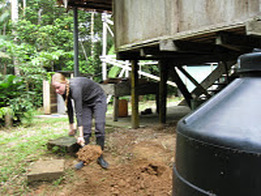Biogas digester project

The evaluation from our Pilot Project indicated a widespread need for our combined community development projects and technical education in clean water, power, and sanitation. To that end, two skilled volunteers went to Peru to establish Future Scientist's continued presence. In creating roots in a community, we wworked closely with Project Amazonas at their Madre Selva field station to set up a base for sustainable community interaction. We are initially focusing on developing a biogas digester system as a solution to waste disposal, energy, and fertilizer needs. This digester will transform waste contamination to clean fuel for cooking and fertilizer for farming. This project will reduce pathogen contamination, provide sustainable cooking fuel, and expand existing farming capability.
A biogas digester, or methane digester, turns organic waste into usable fuel to provide low-cost fuel to people in poverty as well as help dispose of waste materials in a sustainable manner. The biogas digester relies on bacterial decomposition of waste consisting of a range from farm scraps to human waste. This waste attracts bacterial organisms which emit a number of useful gases, most notably methane, in the process of digestion and decomposition. These gases can be harnessed to generate power.
In a biogas digester, anaerobic digestion and fermentation are taken advantage of to create useful gases that are then vented to a storage container. From this storage container, the resulting biogas can be burned as fuel for cooking, heating, and electricity generation for the community to have clean, sustainable power. The sludge which remains in the biogas digester after fermentation can be used for fertilizer on farms.
Read Brigitte's blog about how she and Frances developed the biogas digester over several months.
A biogas digester, or methane digester, turns organic waste into usable fuel to provide low-cost fuel to people in poverty as well as help dispose of waste materials in a sustainable manner. The biogas digester relies on bacterial decomposition of waste consisting of a range from farm scraps to human waste. This waste attracts bacterial organisms which emit a number of useful gases, most notably methane, in the process of digestion and decomposition. These gases can be harnessed to generate power.
In a biogas digester, anaerobic digestion and fermentation are taken advantage of to create useful gases that are then vented to a storage container. From this storage container, the resulting biogas can be burned as fuel for cooking, heating, and electricity generation for the community to have clean, sustainable power. The sludge which remains in the biogas digester after fermentation can be used for fertilizer on farms.
Read Brigitte's blog about how she and Frances developed the biogas digester over several months.

